Broken News
(All the News That's Fit to Reprint)
New Vehicle Inspection Agency Chosen
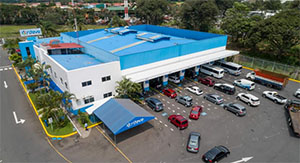 |
| A Riteve Inspection Center |
Our new president, Sr. Rodrigo Chaves announced shortly after assuming his office in May of this year, that he was canceling the contract with the Spanish company known as Riteve SyC which provided vehicle inspection services throughout Costa Rica. Riteve had enjoyed this contract for 20 years. The contract with Riteve also provided that upon termination of the contract all the inspection center property (13 inspection centers) would revert to the government, which it has. It can now be made available to the new contractor.
 |
In late August, Chaves, through his Minister of Public Works and Transport (MOPT), Luis Amador announced that, of 11 companies submitting bids, the German company DEKRA had won the contract for two years and is expected to start providing inspections by late September. DEKRA is a company founded in 1925 and currently employs almost 50,000 people in more than 20 countries worldwide, including the United States and Canada. In Latin America, the company has a presence in Chile and Mexico.
Praising his MOPT manager for a job well done, President Chaves said: “We have a company of enormous international prestige that is going to do the vehicle inspection in Costa Rica according to the way we fought so hard to be able to do it and at half the price and without charging for the second inspection.” Accordingly, the regulatory agency (ARESEP?) followed with an approval of a reduction of between 44% and 49% from the rates charged previously for the Revisión Técnica Vehicular (RTV) and re-inspection will be free for all users.
GG Opinion: The more I see in the decisions being made by our new president, Señor Chaves, such as the sale of non-government business assets like government-owned banks and also this attempt at lowering costs and improving results, the more I believe he displays the financial balance and interest that Costa Rica needs to grow positively.
More Costa Rican Tech Going to Space
The Costa Rican Space Agency was formerly established in 2021 and headed by Franklin Chang-Diaz, a native Costa Rican and former NASA Astronaut. To read more on Chang-Diaz and the Latin American effort in the Space Race go HERE.
 |
| “Proyecto Musa” |
Since then Chang-Diaz´ private company, AdAstra, has been involved with projects that installed tracking radar that follows, or tries to, some 200,000 pieces of low-orbital space junk, information that is used by governments and involved private companies like Amazon and Space-X who plan many launches in the future.
Now another project has involved Costa Rican space efforts, the launch of a sensor cube called “Proyecto MUSA” (Musa Project - shown in the photo), a device made wholly in Costa Rica. This equipment will make a couple of sub-orbital missions (launched out of Sweden) to measure, record and provide information and possible solutions concerning the “Panama disease“, a very serious illness that attacks banana plantations. In addition to the cooperative effort using the Swedish Spaceport, also involved are Orbital Space Technologies (OST), the (TEC or Tecnológico de Costa Rica or Costa Rican Technological Institute) as well as the Central American Association of Aeronautics and Space (ACAE).
AdAstra and Chang have also been awarded a NASA contract to design a plasma propulsion engine to be used for future space exploration. Recent tests on the premier engine cleared the way for the possibility that it could be in space-use by 2025.
Pura Vida amigos y ve a donde ningun hombre ha ido antes (go where no man has gone before)!
Classic Costa Rica Exports Off Substantially
Data from the Cámara de Comercio Exterior (CRECEX) – Chamber of Foreign Trade, reveal a 55% drop in banana exports in the first half of this year, compared to the same period in 2021. At the same time coffee exports dropped 60% year-to-year. These have always been two of the classic and important exports of Costa Rica.
Last March an official from the INCAE Business School said that: "...the Russia and Ukraine conflict would have big repercussions on the world economy and Costa Rica would be no exception." Unfortunately, he was right on the money that we would be right off the money.
201st Independence Day
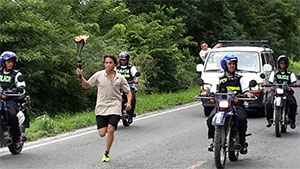 Independence Day in Costa Rica was September 15, a paid holiday. It celebrates the declaration of independence from Spain that Costa Rica made in 1821 and 2022 which makes it the 201st anniversary of this celebration. The red, white and blue bunting poured forth from what seemed like every crack and crevice in Quepos as I´m sure it did throughout Ticoland. And it was fitting that all the school boys and girls could get out their drums and horns and blast away exercising a post-Covid release of energy.
Independence Day in Costa Rica was September 15, a paid holiday. It celebrates the declaration of independence from Spain that Costa Rica made in 1821 and 2022 which makes it the 201st anniversary of this celebration. The red, white and blue bunting poured forth from what seemed like every crack and crevice in Quepos as I´m sure it did throughout Ticoland. And it was fitting that all the school boys and girls could get out their drums and horns and blast away exercising a post-Covid release of energy.
Another facet of this celebration is a running of the Freedom Torch throughout Central America from Guatemala to Costa Rica shown in the photo above. To see what this holiday means to us, go HERE.
Correction: A recent press report pointed out that Thursday, September 15, 2022 was not really a legal paid holiday. A law was passed during the Covid period that moved holidays to be celebrated on Fridays or Thursdays to take advantage of three day weekends. So the actual day off this year will be Monday, September 19. (Comment: You´d never know it had been changed when you look at all the kiddies and parading going on in downtown Quepos on Thursday, Septemeber 15 - maybe we´re sliding in an actual two-day holiday?
¡Pura Vida!
TOP
Economic Drumbeat
(Costa Rica Business Happenings)
VAT Increases for Construction Sector
 To encourage "economic reactivation", as the local press likes to call it, the normal 13% VAT sales tax on engineering, architecture, surveying, and civil engineering services was suspended from September 16, 2020 to August 31, 2021 in reaction to the pandemic. The tax was then later restored to 4% until August 31, 2022 and then once again increased to 8%. The current rate of 8% will remain in force until September 1, 2023 when it will return to the full VAT rate of 13%.
To encourage "economic reactivation", as the local press likes to call it, the normal 13% VAT sales tax on engineering, architecture, surveying, and civil engineering services was suspended from September 16, 2020 to August 31, 2021 in reaction to the pandemic. The tax was then later restored to 4% until August 31, 2022 and then once again increased to 8%. The current rate of 8% will remain in force until September 1, 2023 when it will return to the full VAT rate of 13%.
As might be expected, the construction sector would like to see a slower tax regeneration rate to spur reactivation but the amounts were codified into law and are unlikely to change unless there is another collapse in the segment. We´re coming back amigos.
Gasoline See-Saws Once more, This Time Downward
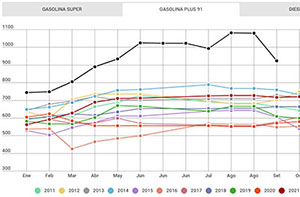 |
| Costa Rican Regular Gas Price Historically |
Like in most places around the world the price of gasoline has see-sawed recently first up and then occasionally down. The chart of recent historical values is shown to the right. Most of the trend was upward but the government´s regulatory authority recently announced a substantial decline in the price per liter of regular equal to 156₡/liter (using the exchange rate of 665₡/$ at the time I wrote this, that equals $0.88/gal). The new regular price level becomes 922₡/liter or $5.21/gal. Still no bargain at this price as a quick check of the prevailing average in the U.S. (Florida) is $3.55/gal; but it´s an improvement.
Sometimes I wax nostalgic and recall that for my first car in 1959 I paid $0.25/gal for regular gas or $5 to fill a 20 gal tank, hah, hah, hah...really? There was no Super then, just regular and Lincoln was president - just kidding - please, go easy on me, I get carried away.
Ten Millionth Passenger at Liberia Airport
Most people coming to Costa Rica, including residents, usually pass through our largest airport, SJO, officially Juan Santamaria in the San José suburb of Alejuela. I have watched that airport grow from about six gates in 2003 to the current 20 today. In 1995 the other major international airport, call letters LIR but also known as Liberia, Daniel Otuber or Guanacaste Airports opened near the town of Liberia on the north Pacific coast.
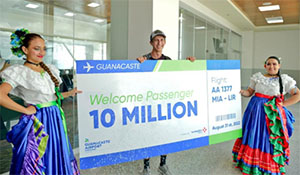 Since that time the Guanacaste Airport has continuously grown and now sports 8 gates. It also has continuously added more and more flights from various countries. To mark a new threshold the airport authority recently presented an unsuspecting passenger with a certificate naming him the 10,000,000th passenger to use LIR. The young man involved was a fella named Jake Hubbell, a 26-year old from Colorado come to attend a friend´s wedding in Guanacaste. Said Jake: “I am very surprised, it was totally unexpected. I knew that Costa Rica was very welcoming but I did not imagine that much.”
Since that time the Guanacaste Airport has continuously grown and now sports 8 gates. It also has continuously added more and more flights from various countries. To mark a new threshold the airport authority recently presented an unsuspecting passenger with a certificate naming him the 10,000,000th passenger to use LIR. The young man involved was a fella named Jake Hubbell, a 26-year old from Colorado come to attend a friend´s wedding in Guanacaste. Said Jake: “I am very surprised, it was totally unexpected. I knew that Costa Rica was very welcoming but I did not imagine that much.”
And it was not just the certificate presented to him by the pretty girls in native dress as seen in the picture; Jake also received a number of other gifts including a plane ticket to Guanacaste for two on American Airlines.
I´ll bet you were a star at the wedding reception amigo.
Bill to Sell BCR Bank Goes to Legislature
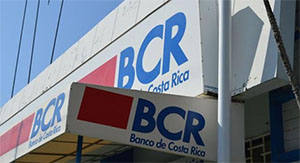 Following up on his plan to withdraw the government form some commercial enterprises, President Chaves and his Minister of Finance, Nogui Acosta signed a bill on Wednesday, September 7 that would present Banco de Costa Rica (BCR) for sale. The process of the management of the sale would fall to the governing council (Cabinet) under the guidance of the Banco Central (Central Bank) and supervised by the Ministry of Finance. A "Sales Committee" made up of ministers of Finance, Presidency, Planning, Economy and Labor would be responsible to “... formalize the award and respective contract”. At the present time, the government has set the value of BCR at $1.78 billion.
Following up on his plan to withdraw the government form some commercial enterprises, President Chaves and his Minister of Finance, Nogui Acosta signed a bill on Wednesday, September 7 that would present Banco de Costa Rica (BCR) for sale. The process of the management of the sale would fall to the governing council (Cabinet) under the guidance of the Banco Central (Central Bank) and supervised by the Ministry of Finance. A "Sales Committee" made up of ministers of Finance, Presidency, Planning, Economy and Labor would be responsible to “... formalize the award and respective contract”. At the present time, the government has set the value of BCR at $1.78 billion.
The bill must now pass the legislature to became law and initiate the process. That´s not at all a sure thing as the passage of the bill, according to the legislature, requires a “qualified majority” which is 38 of the 55 legislators whereas Sr. Chaves´s party controls only 10. Whether or not it becomes law, GG believes that the new president has demonstrated squarely his belief that government should not be competing in private industry with businesses such as residential and commercial banking.
¡Pura Vida!
TOP
Latin America Updates
(Major Events In Neighboring Countries)
Chile
 After suffering widespread and sometimes violent protests about economic conditions in Chile in 2019, the government drafted a new constitution in 2020.
After suffering widespread and sometimes violent protests about economic conditions in Chile in 2019, the government drafted a new constitution in 2020.
 |
| Gabriel Boric |
A national plebiscite was recently held on the new leftist leaning constitution which went down to defeat with Chileans voting "No" - 62% vs "Yes" - 38%, on acceptance. The economic climate has changed in Chile since 2019 and polls suggested the following concerns were at work in the election results:
- "plurinationality" expressed as greater benefits and pension sharing with indigenous groups
- legalized abortion in a country 50% Catholic
- environmental constraints in a country that is the #1 producer of copper in the world
President Gabriel Boric, who was in favor of the new constitution, vowed to pursue the concerns and constitutional changes by individual proposal.
Colombia/Venezuela
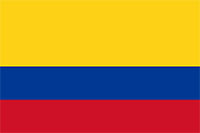
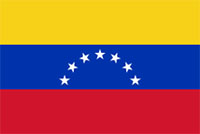 After a three year break in formal diplomatic relations with and the election of a leftist president in Colombia by the name of Gustavo Petro, the governments of Venezuela, led by Nicolas Maduro, and Colombia restored full diplomatic relations on August 28, 2022. Colombia, which had been conservative for several governments, was last run by Ivan Duque, who had refused to recognize Maduro as the legitimate leader of Venezuela resulting from the last election.
After a three year break in formal diplomatic relations with and the election of a leftist president in Colombia by the name of Gustavo Petro, the governments of Venezuela, led by Nicolas Maduro, and Colombia restored full diplomatic relations on August 28, 2022. Colombia, which had been conservative for several governments, was last run by Ivan Duque, who had refused to recognize Maduro as the legitimate leader of Venezuela resulting from the last election.
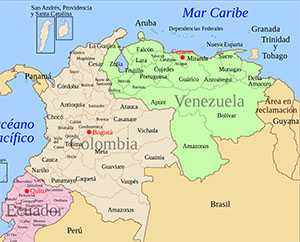 Air service between the two countries as well as embassies and consulates had been shut down. The two countries share a 2,000-kilometer (1,200-mile) land border between them which had been closed between 2019 and October 2021 and then opened to pedestrians only. Caracas and Bogota have also announced intentions to restore military relations. Venezuela already is in league with Iran and recently showcased a new joint venture drone constructed in Venezuela with the assistance of Iranian technology containing "use capabilities" that include “Observation, reconnaissance and attack, with anti-tank and anti-personnel capabilities”.
Air service between the two countries as well as embassies and consulates had been shut down. The two countries share a 2,000-kilometer (1,200-mile) land border between them which had been closed between 2019 and October 2021 and then opened to pedestrians only. Caracas and Bogota have also announced intentions to restore military relations. Venezuela already is in league with Iran and recently showcased a new joint venture drone constructed in Venezuela with the assistance of Iranian technology containing "use capabilities" that include “Observation, reconnaissance and attack, with anti-tank and anti-personnel capabilities”.
The new Colombian ambassador to Venezuela also noted that eight million Colombians make a living from trade with Venezuela so trade relations between the two countries are also expected to resume.
Nicaragua

1. Nicaragua Going Nuclear. On August 28 this year, President Daniel Ortega issued decree #16-2022 establishing the Nicaraguan Commission for the Development of Atomic Energy for Peaceful Purposes. (Issuing decrees is so much easier than having to go through troublesome legislative processes to create laws -ed.) The idea for the Atomic Commission is “to promote the development and use of atomic energy in agriculture, medicine, industry, science and technology,” says the government. Sure it is.
The institution will be called the Nicaraguan Council for Science and Technology (Conicyt) and controlled by the Office of the Vice Presidency, i.e., Rosario Murillo, the wife of President Ortega. The stated goal for the new organization is to "...promote the design and construction of nuclear facilities, particle accelerators, neutron generators and other sources of ionizing radiation.”
Ortega´s decree clearly states that the intent is “to create an atomic energy infrastructure for Nicaragua,” although he insists that it is for “peaceful” purposes. Yup, right.
2. Exodus of Priests Continuing. Since the political uprisings of 2018, when some 320 people were killed across the country by both national police and quasi-military squads encouraged by the government, the Ortega regime of President Daniel and his wife Rosario Murillo have been eliminating their opposition by incarcerating them, closing down press offices and putting their political opponents under house arrest.
The last opposition they needed to tame was the Catholic Church, who had opened their churches to purge victims during the unrest by providing aid and shelter. So the persecution of catholic clerics began. Vice President Murillo, and wife of President Ortega, has been quoted as publicly stating that bishops and priests are "sons of the devil". At least six priests crossed the southern border into Costa Rica in August, some of which were escaping death threats.
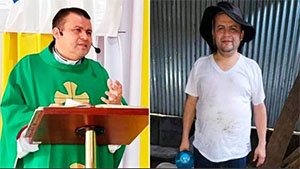 |
| Fr. Vallejos And As An Immigrant |
A typical story of persecution is reiterated by one Father Uriel Vallejos, a parish priest in the northern city of Sébaco. Police entered his church in August, but missed him, as the priest had been alerted to the action and he escaped to a parish home where he held up for three days existing on bread, water and yogurt. After that he slipped out in the middle of the night and, dressed as an immigrant, snuck across the southern border into Costa Rica. Said the good father: “Leaving like this is traumatic. It is an inhumane condition, but I had to do it to safeguard my life.”
In other similar stories: 1) The Bishop of Matagalpa, Monsignor Rolando Álvarez, is under house arrest by the Nicaraguan Police; 2) four priests who were with Alvarez were also placed under house arrest; 3) eight clerics who accompanied Álvarez, including four priests, were taken to the El Chipote police prison, a well-known torture center where the regime sends most of its political prisoners. 4) in April 2019, the auxiliary bishop of Managua, Monsignor Silvio Báez, went into exile by order of the Vatican, after receiving death threats; Said Báez: "I feel sad. My heart is broken by the pain of leaving Nicaragua, but I am serene and at peace knowing that I am always available to serve the Lord and the Church wherever I am asked."
So this is one more example why the Ortega Regime has been sanctioned by the United States, Canada and the European Union.
Panama
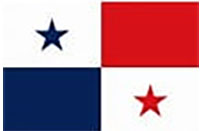
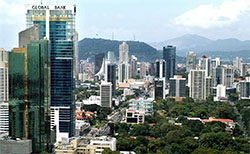 |
| Panama City Skyline |
Panama is actively marketing itself as a place where large companies can strenghthen their supply chain. Buoyed up by an expanded Canal, a stable government and a positive business attitude as well as a long history of working with international shippers, the country sees itself in a very favorable position to attract considerable foreign investment.
¡Solo Bueno!
TOP
Climbing Mount Chirripó
(Costa Rica´s Tallest Mountain)
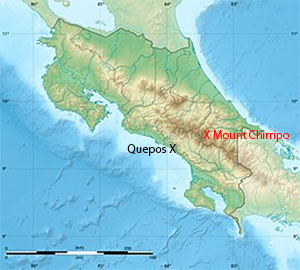 |
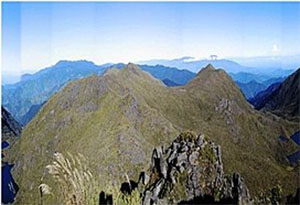 |
| Mount Chirripó - Foreground |
While Mount Chirripó is not in the same league of mountains as Mount Everest (8,849 meters/29,032 feet) it still is a formidable hill to climb at 3,820 meters/12,530 feet. And you don´t have to battle snowdrifts and avalanches on the way up (although snow flurries and hail have occasionally been reported near the summit).
The mountain was named "Chirripo" by indigenous Costa Ricans, which means "land of eternal waters", because there are many lakes and streams around the mountain.
The mountain is located in what is known as the Talamanca Range, a part of the Cordillera Central or central mountain spine that dissects the country running southeast from the Nicaraguan border down to the Panama border. That places Chirripó only 97 kilometers east of Quepos or only about an hour and a half by car or tourist van.
Mount Chirripó is located in the Chirripó National Park (509 sq km or 196 sq mi) which is known for its extensive biodiversity. Five ecosystems have been identified, namely: lowland tropical wet forest, premontane tropical wet forest, lower montane wet forest, montane wet forest and subalpine wet forest (páramo). Temperatures at the peak range from 4˚C (39F) to 18˚C (84F) in the daytime and can drop to below freezing at night. The coldest temperature ever recorded in Costa Rica (−9 °C (16 °F)) was recorded in the Chirripó National Park.
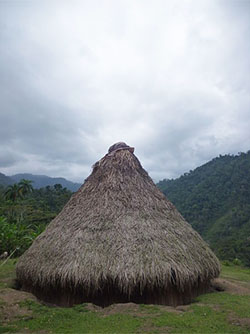 |
| Traditional Cabécar House |
The Talamanca Region is home to several indigenous groups and the Chirripó mountains are the home of the Cabécar people, the current population estimated to be around 17,000 people. The Cabécar are an indigenous people that speak their own language, also called Cabécar, a derivative language belonging to the Chibchan family of languages and commonly found in the Isthmas-Colombian Area of lower Central America and northwestern Colombia.
Many of the Cabécar people live in government sponsored reservations shown on the map to the left. These reserves: "...exhibit ecological diversity, including vast swaths of tropical rainforest covering steep escarpments and large river valleys where many Cabécar still employ traditional subsistence livelihoods and cultural practices."
The Cabécar are the largest Indigenous group in Costa Rica and are considered to be the most isolated. They have been pushed up to the Chirripo Mountains, which requires a few hours long hike to reach. Therefore, the Cabécar have not been exposed to many basic items, and few of them have been exposed to education. They are very traditional and have preserved their culture. They speak mostly in their own language rather than Spanish.
The park, like almost all of Costa Rica is subject to a dry season (December to April) and a wet season (May to November). The literature includes a cautionary from government offices that: "During the dry season the upper regions are susceptible to fires. The latest recorded fire events have occurred in 1953, 1958, 1976, 1977, 1981 and 1992. This last event, however, affected over 20 sq km (7.7 sq mi) of vegetation and forced the administration to close the park for four months." Here amigos is another reason to consult the tour guides early about the prevailing condition and situation if you plan to hike up Chirripo.
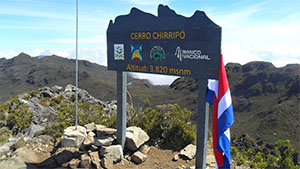 |
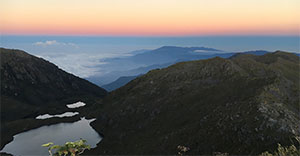 |
| At the Chirripó Summit |
Climbing Mount Chirripó is possible by obtaining a permit from the National Park office in San Gerardo de Rivas, a small (population less than 400) village high up in the valley of the Chirripó Pacífico river in the Talamanca Mountains. It is 20 kilometers northeast of San Isidro de El General, which is the second-largest city in San José Province. From the trail head to the peak, the hike on foot runs 19.5-kilometers (12.1 miles). The reward: on clear days at the summit it is possible to see across the country from the Pacific Ocean to the Caribbean Sea. And the mountain views are truly breathtaking.
GG can´t offer his personal report on making this trek as I´ve never done it and maybe never will since the last jaunt into the mountains I took in 2019 resulted in a damaged and infected leg that earned me 6 days in the local hospital consuming copious amounts of three different antibiotics. Mad Mountain Dean I ain´t no more.
A few years ago, a friend and his wife in their 50´s, who had lived here for over 10 years, decided to climb Chirripó. They actually went into training for a couple of weeks of daily exercise guided by a physical trainer. They made the summit and after they returned I noticed that they both walked around like some form of robots trying not to reduce any strain in their body and overtaxed muscles. Yup, methinks, they actually did do Chirripó.
So, if you´re considering climbing our highest mountain, be sure to respect the terrain involved and consult with the guides and people that have done it before. GG wishes you the best if you decide to do the trek, it´s gotta be really kool at the top.
¡Pura Vida!
TOP
Rumble and Weather Talk
(Shaky Happenings & Weather Observations About the Pacific Rim)
Rumbling - 5.6 Shaker in the Osa
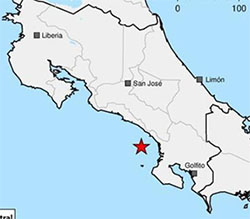 On the 5th of September at 12.53am a shaker hit near the Osa Peninsula (see map) with an epicenter 26 km southwest of Bahia Ballena (near Uvita and only about 79 km down the coast from Quepos). It was recorded as a magnitude 5.6, 15 km deep (shallow) and a second event occurred shortly thereafter. Both were described as "telluric movements" (i.e., when friction occurs at the edges of a tectonic plate)
On the 5th of September at 12.53am a shaker hit near the Osa Peninsula (see map) with an epicenter 26 km southwest of Bahia Ballena (near Uvita and only about 79 km down the coast from Quepos). It was recorded as a magnitude 5.6, 15 km deep (shallow) and a second event occurred shortly thereafter. Both were described as "telluric movements" (i.e., when friction occurs at the edges of a tectonic plate)
The earthquake was felt as far away as the Central Valley. GG is happy to report he felt nothing - must have been snoozing at that time of night. I´m getting better at sleeping through these things.
Mexico
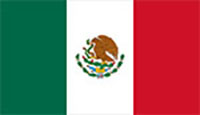 September 19 is a important date, now having gone down in Mexican history several times.
September 19 is a important date, now having gone down in Mexican history several times.
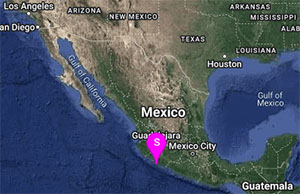 On September 19, 2022, a major earthquake hit the western coast of the country several hundred kilometers west of Mexico City. The Mexican National Seismological Service first rated the magnitude at 6.8 but later revised it to 7.4. The U.S. Geological Survey put the magnitude at 7.6. One death was reported in the Pacific port of Manzanillo attributed to a wall collapse. The USGS warned that tsunamis could be generated and waves of 10 ft were later reported.
On September 19, 2022, a major earthquake hit the western coast of the country several hundred kilometers west of Mexico City. The Mexican National Seismological Service first rated the magnitude at 6.8 but later revised it to 7.4. The U.S. Geological Survey put the magnitude at 7.6. One death was reported in the Pacific port of Manzanillo attributed to a wall collapse. The USGS warned that tsunamis could be generated and waves of 10 ft were later reported.
September 19, 2017. Five years ago to the day another major quake, much closer to Mexico City was recorded at a strenght of 7.1. It resulted in over 200 fatalities and 1,300 injuries.
September 19, 1985. This date represents the worst record on this day so far. On this date an 8.1 shaker hit the capital, Mexico City and killed over 5,000.
If I were Mexican I think I would take my vacation in 2023 of about two weeks, right in the heart of September, and visit Costa Rica.
Check Out Recent Earthquakes All Around the World Posted by the U.S.G.S. Recent Quakes |
Weather - Tragedy in Central Valley
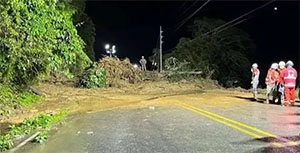 |
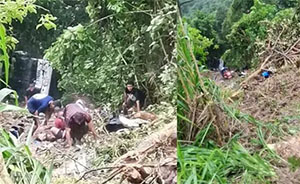 |
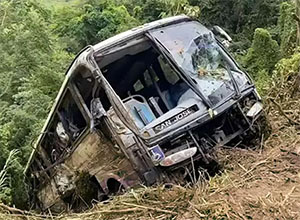 |
The "Derrumba (Slide)", Bus in Ravine,
Bus being Extracted |
We´ve been having steady rains this season with heavy downpours in many parts of Costa Rica. Particularly hard hit in mid-September was the Central Valley including San José and Alejuela Provinces. The weekend of September 17 saw the National Weather Service raising the rain warning in that area from Yellow Alert to an Orange Alert.
On Saturday afternoon, September 17 President Chaves went visiting affected areas south of the capital that have experienced flooding; he then ordered the evacuation of affected families.
Shortly after that, about 4 pm in the afternoon a bus with some 60 passengers was in the Cambronero region of Alejuela on Ruta 1 making its way toward Guanacaste when the landslide occurred. The "derrumba" (the word stemming from the Spanish to ´demolish´) first hit a number of cars pushing them against the bus, which then itself was pushed over a cliff and down a 200+ foot embankment.
The slide occurred on Ruta 1, also known as the Inter-Americana Highway, the road that runs "To Everywhere" or at least from Alaska to Tierra del Fuego in Argentina. This is a very busy and important highway in Costa Rica. GG wrote one of his earliest articles about the Interamericana which can be read HERE. After the accident the road had been closed until further notice.
Unfortunately the bus casualties included 9 killed and a number injured, at least 3 critically. There were also some 7 people caught in the bus that would later would need to be extricated. Some 32 units from the Red Cross and 23 from the Bomberos (Firefighters) responded to the disaster.
After assessing the situation further, the Ministry (MOPT) responsible for transportation decided on September 25 that the Cambronero route will remain closed for the next three months. At the same time, the Costa Rica weather service issued a forecast for very strong rains coming in the next two months, a period which traditionally finishes up the rainy season.
It´s not just about rain amigos, it´s about what the rain can do.
¡Pura Vida!
TOP
Search the Golden Gringo Chronicles Archives for Topics That Interest You
You can use our Archives to search for anything that has been written in more than 320 feature articles of the Golden Gringo Chronicles plus find Broken News items and ROMEO restaurant reviews. Enter your topic or item to search in the Google Search Routine below and follow the links offered from the search results.
Suggestion: Enter only a simple, precise and unique as possible key word or two in order to narrow the number of references retrieved:
Golden Gringo Chronicles - Enter Search Here
Readers: Our publication is open to suggestions regarding future articles
and will accept pieces written by others but we reserve the right to decline
anything that the
editorial staff (that's GG) thinks is inappropriate for this format. Send proposals, comments, suggestions, ideas, meaningless statements and jocular observations concerning the Chronicles to GG here: gg@goldengringo.com.
The Legend of Witch´s Rock
(Hanging Ten With The Evil Spirits)
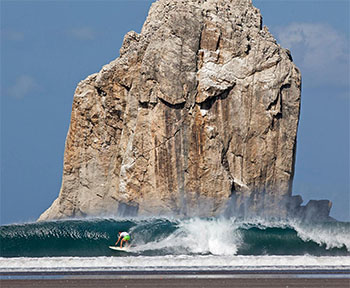 |
| Surfing Roca Bruja or Witch´s Rock |
Parque Nacional Santa Rosa (Santa Rosa National Park) is located in Guanacaste Province on the northwest corner of the Pacific Coast of Costa Rica. In this park there is a very large rock (check out the photo left) that gives the place its signature name.
The beach where this rock can be found is called Playa Naranjo (Orange Beach), and the rock that gives the spot its name is just a few hundred meters offshore. It´s somewhat remote compared to other places in Costa Rica but lodging and several surf camps can be found in the Tamarindo area which is nearby.
The rock, known as Roca Bruja or Witch´s Rock has become known as a top surfing spot and that´s because of it´s special "break". To a surfer, a break is defined as follows:
"A surf break (also break, shore break or big wave break) is a permanent (or semi permanent) obstruction such as a coral reef, rock, shoal or headland that causes a wave to break, forming a barreling wave or other wave that can be surfed, before it eventually collapses. The topography of the seabed determines the shape of the wave and type of break."
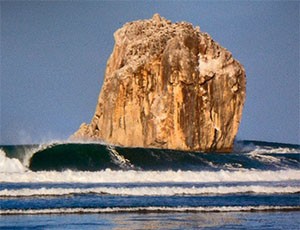 |
| Gnarley Breaks At Witch´s Rock |
Waves at Roca Bruja that result from the rock and the underwater structure around it are described as "epic", "breathtaking", "legendary" and with many other adjectives. They are also described by the surfboard illuminati as being of the types that swing left, right, and/or in A-frame formation. For surfers the good news is also reported that these are some of the most consistent waves to be found in this part of the world. (Wow, GG didn´t know there was such a thing as surf engineering.)
Caution: This is not a place for beginners. The waves are strong, heavy, and fast, the access difficult and the current and winds are strong. Surfers are often overwhelmed by the size and speed of Witch's Rock swells. Intermediate surfers often also struggle at Witch's Rock. The exception is if you are advanced and consistently surf fast and heavy overhead waves. (called "plus" waves by surfers). Those who want to experience the "gnarliest" break, and have the capability to do so, should come to Witch´s Rock.
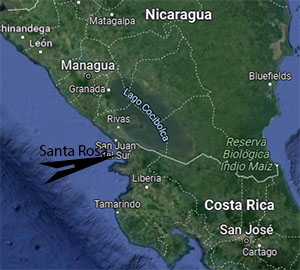 |
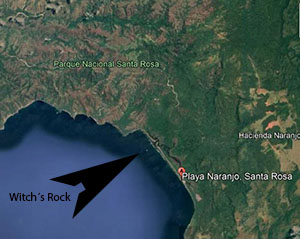 |
| Location of Santa Cruz & Witch´s Rock |
Now, what about the legend. Local folklore for many decades has suggested a witch lives on or in the rock. There are no reports of witch sightings but the legend is reinforced by mysterious, loud whistling sounds that emanate from the rock and which have been reported many times by fishermen and boater passersby. The less easily impressed by legend or folklore now attribute the sound to wind passing through crevices in the rock. There are strong off-shore winds at Roca Bruja and the sound is believed to be caused by the wind passing through these natural rock crevices.
Another reason given for the witchcraft is the apparent and instantaneous relocation of some surfers when viewed from the shore. The currents and wind are strong and the waves so large that it often seems that the surfers position in the lineup has moved. This makes it appear that the rock is moving, when in fact, it is the surfer that has changed their position.
The experts in this area suggest that the best time of the year for surfing at Witch´s Rock is May to December (the dry season) as the rainy season can produce squalls not conducive to easy surfing. In addition there are many other activities in the area such as camping, fishing or just relaxing and enjoying the incredible natural beauty that is Costa Rica.
Every now and then I will make a statement out loud that "Life is good..." to which my Tico friend Jessie always replies: "Life is better when you surf!"
Old GG is beyond his surfing days (actually, I never tried it) but I always enjoy the natural beauty aspects of living here.
¡Pura Vida!
TOP
¿Que es Eso? Department (¿What is That?)
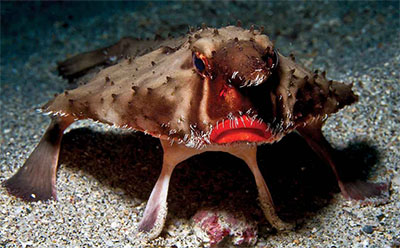
Is this real or a just a toy?
Answer in
What's-in-a-Word
section below.
¡Pura Vida!
TOP
Health Stuff
| Note: The information given in this section is offered as news information only and does not indicate GGC confirmation or denial of the accuracy of the treatment or a recommendation to pursue it, nor can we or do we guarantee the efficacy of the results nor validity of the conclusions proffered.
(How's that for a disclaimer amigos?) |
Hacked Health System Computer Restored
On June 1 the National Health System (CAJA) was hacked by a Russian ransom-ware organization called Conti. The ransom demand of $20 million was quickly refused by the government and software safety systems were ordered for immediate implementation. The hacking caused short term havoc as medical records and communications for tracking and scheduling treatments were interrupted and sometimes lost. The system, known as EDUS or the Expediente Único en Salud (Unique Health File) was reported on August 25 as being restored at 130 of 147 health centers or 88%.
The after-effect of this hacking was to backup appointments and procedures in most of the areas provided by the Caja and controlled by their EDUS system. Although the electronic capability of the system is back, catching up by the health professionals will take an unpredictable amount of time. Thank God these people are dedicated and we thank them for their effort.
When someone messes with my health system, GG wants to strike back. Maybe a new division of the CIA could bring a message to those hackers...eh?
¡Solo Bueno!
TOP
Travel Quote of the Month

¡A Cachete!
TOP
GGC Bookshelf
 GGC Publications Group is the parent organization that publishes the Golden Gringo Chronicles as well as a number of books and paraphernalia related to the Chronicles and Costa Rica. The GGC Bookshelf also includes works from a number of other authors that belong to the Quepos-Manuel Antonio Writers Group in which GGC has been a founding member.
GGC Publications Group is the parent organization that publishes the Golden Gringo Chronicles as well as a number of books and paraphernalia related to the Chronicles and Costa Rica. The GGC Bookshelf also includes works from a number of other authors that belong to the Quepos-Manuel Antonio Writers Group in which GGC has been a founding member.
Here are the books currently on our bookshelf:
All of the above books are available on Amazon.com and the "Read More" links above will lead you to them. You can find more detail on all of them on our GGC Publications Page.
GGC Products Store
GGC Publications also offers some accessories and paraphernalia related to the Chronicles and with Costa Rican themes, to wit:
T-Shirts:

a. Golden Gringo Chronicles with Logo
b. Official Golden Gringo with Monkey on Banana Hammock
c. ¡Quepo en Quepos! ("I Fit In Quepos!") with Photo of Quepos
d. Wanna Monkey Around? - Come on Down! (shown) with Photo of White Faced Monkey, e. It's OK to be Slothful with photo of Three-Toed Sloth.
The t-shirts are available in several themes, colors, styles and sizes. See them all
HERE.
Coffee Mugs:
a. Golden Gringo, b. Wanna Monkey Around?, c. It's OK to be Slothful
See them all HERE:
What's life without a great cup of Costa Rican coffee? And it tastes even better in a Golden Gringo Chronicles mug!
To see ALL the products available in the Golden Gringo Store go here: GGC Store.
¡Solo Bueno!
What's-in-a-Word
"Tell me and I forget; teach me and I remember; involve me and I learn"
– Benjamin Franklin
Answer to Que Es Eso
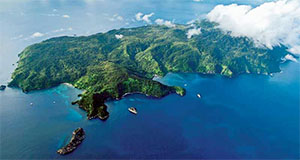 |
| Cocos Island (Isla de Coco) |
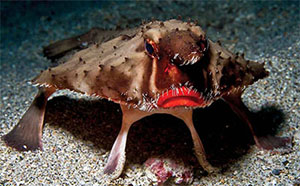 |
| Red-Lipped Batfish |
About 550 kilometers (342 miles) off the Pacific Coast of Costa Rica lies an island known as Cocos Island. The island is sizable at 23.9 square kilometers or 9.2 square miles and is a territory as well as a National Park administered by Costa Rica. It has no residents except for Park Rangers and can only be reached by sea after a 36-48 hour boat trip. The island itself is actually a district that is part of Puntarenas Province. It has also been designated a UNESCO World Heritage site since 1997.
Cocos island is a diver´s favorite because of it´s rich marine life having a great population of rays and dolphins and at least three species of shark including hammerheads and white tips. Snorkel carefully my friends.
This is also where you find the Rosy-Lipped Batfish (photo), a cousin to the red-lipped batfish found in the Galapegos Islands and offshore Peru.
The snout and horn of the rosy-lipped batfish is a brownish color. As the name of the fish states, the batfish has bright, almost fluorescent red lips. "Batfish are not good swimmers; they use their highly adapted pectoral, pelvic and anal fins to "walk" on the ocean floor."
GG hasn´t seen a face with a grimace like that since having a sixth grade teacher who was a somewhat petulant nun.
¡Aura Vida!
TOP
ROMEO Corner
(Retired Old Men Eating Out)
Marisqueria Sabromar, Quepos
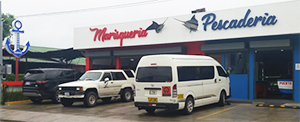 Location: Just over the Quepos bridge to San José about 200 meters on the left.
Location: Just over the Quepos bridge to San José about 200 meters on the left.
Hours: Lunch and Dinner Sunday thru Monday
Parking: Limited customer parking in front.
Contacts: Phone: 506 2777-7767
Facebook:https://www.facebook.com/marisqueriasabromar
Reviewing ROMEOS: Bob N., Harry R., Olga C., Roger B., Ruth R.
To Review Our Rating System Go Here: R.O.M.E.O. Rating System. This restaurant was last reviewed in 2019; read that review HERE.
 This restaurant has not changed much physically, nor its location in Quepos, since our last reviewing in July of 2019. The company that owns and runs it is a long-time fishing company out of Puntarenas. The location offers not only the restaurant but also a retail shop where fresh seafood can be purchased in large quantities. The restaurant has a compact dining room and an outdoor area under roof that borders up to a fishing dock. There is a limited view of the Quepos harbor and Marina Pez Vela from the outside dining area.
This restaurant has not changed much physically, nor its location in Quepos, since our last reviewing in July of 2019. The company that owns and runs it is a long-time fishing company out of Puntarenas. The location offers not only the restaurant but also a retail shop where fresh seafood can be purchased in large quantities. The restaurant has a compact dining room and an outdoor area under roof that borders up to a fishing dock. There is a limited view of the Quepos harbor and Marina Pez Vela from the outside dining area.
The composite score for ambiance came in at 3.2 out of 5.0 max.
The menu is somewhat limited but especially focused on a variety of seafood dishes from fish fillets to deep fried options such as fish fingers, shrimp, octopus and other seafood varieties. Fish and other seafood also appear in dishes with rice, Costa Rican style, or pasta in red or white sauces.
GG ordered a fillet of fish that was finished in a white sauce containing small, whole and tender shrimp. The dish came with mashed potatoes and steamed vegetables. The fish taste and freshness of the shrimp was excellent and the basic sauce flavored with cilantro very tasty.
Other ROMEOs ordered a fish fillet with a mixture of seafood and others went for fish fingers. All reports were good and the composite score for food quality came in at 4.6/5.0. |
 |
.jpg) .0 .0 |
| $$.9 |
Value Index= 138 |
Service was provided by a gentleman whose name currently escapes me but who has been there for some time. He was friendly, cooperative (didn´t hesitate when GG asked him to join two tables even though we didn´t end up using both of them). The composite score for service was placed at 4.1/5.0.
The bill for GG´s fish fillet in the shrimp white sauce came in at 7,021 colones or about $11 at the current exchange rate. The composite score for cost came in at 2.9/5.0 giving an average for ambiance (3.2), food quality (4.6) and service (4.1) of 4.0 and yielding at Value Index of 4.0/2.9 = 138 which puts Marisqueria Sabromar in the top 20% of value for restaurants we´ve reviewed in this area.
The ROMEOs can confirm that Marisqueria Sabromar continues to provide excellent quality seafood at a reasonable price.
¡Solo Bueno!
TOP
Opt-In Here to Receive Your Free Monthly Copy Of
The Golden Gringo Chronicles
The Golden Gringo Chronicles is a free newsletter that is non-political, non-commercial and, hopefully, informative and entertaining. By signing up you will receive an email each month around the first of the month giving you the links to the latest edition as well as to each individual feature and departmental section.
CLICK HERE TO SIGN-UP FOR THE GOLDEN GRINGO CHRONICLES
or Email me at gg@goldengringo.com, or use our Website at: www.goldengringo.com

Bob Normand, Editor & The Golden Gringo
Pura Vida!
To Contact GGC World Headquarters (yuk, yuk) to makecomments, suggest topics or criticize my bad jokes, just send an email to: gg@goldengringo.com.
Be pithy but kind; I'm sensitive.
Unsubscribe from Golden Gringo Chronicles




 Independence Day in Costa Rica was September 15, a paid holiday. It celebrates the declaration of independence from Spain that Costa Rica made in 1821 and 2022 which makes it the 201st anniversary of this celebration. The red, white and blue bunting poured forth from what seemed like every crack and crevice in Quepos as I´m sure it did throughout Ticoland. And it was fitting that all the school boys and girls could get out their drums and horns and blast away exercising a post-Covid release of energy.
Independence Day in Costa Rica was September 15, a paid holiday. It celebrates the declaration of independence from Spain that Costa Rica made in 1821 and 2022 which makes it the 201st anniversary of this celebration. The red, white and blue bunting poured forth from what seemed like every crack and crevice in Quepos as I´m sure it did throughout Ticoland. And it was fitting that all the school boys and girls could get out their drums and horns and blast away exercising a post-Covid release of energy. To encourage "economic reactivation", as the local press likes to call it, the normal 13% VAT sales tax on engineering, architecture, surveying, and civil engineering services was suspended from September 16, 2020 to August 31, 2021 in reaction to the pandemic. The tax was then later restored to 4% until August 31, 2022 and then once again increased to 8%. The current rate of 8% will remain in force until September 1, 2023 when it will return to the full VAT rate of 13%.
To encourage "economic reactivation", as the local press likes to call it, the normal 13% VAT sales tax on engineering, architecture, surveying, and civil engineering services was suspended from September 16, 2020 to August 31, 2021 in reaction to the pandemic. The tax was then later restored to 4% until August 31, 2022 and then once again increased to 8%. The current rate of 8% will remain in force until September 1, 2023 when it will return to the full VAT rate of 13%.
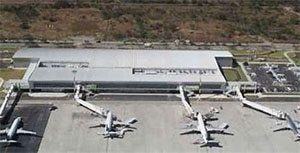
 Since that time the Guanacaste Airport has continuously grown and now sports 8 gates. It also has continuously added more and more flights from various countries. To mark a new threshold the airport authority recently presented an unsuspecting passenger with a certificate naming him the 10,000,000th passenger to use LIR. The young man involved was a fella named Jake Hubbell, a 26-year old from Colorado come to attend a friend´s wedding in Guanacaste. Said Jake: “I am very surprised, it was totally unexpected. I knew that Costa Rica was very welcoming but I did not imagine that much.”
Since that time the Guanacaste Airport has continuously grown and now sports 8 gates. It also has continuously added more and more flights from various countries. To mark a new threshold the airport authority recently presented an unsuspecting passenger with a certificate naming him the 10,000,000th passenger to use LIR. The young man involved was a fella named Jake Hubbell, a 26-year old from Colorado come to attend a friend´s wedding in Guanacaste. Said Jake: “I am very surprised, it was totally unexpected. I knew that Costa Rica was very welcoming but I did not imagine that much.” Following up on his plan to withdraw the government form some commercial enterprises, President Chaves and his Minister of Finance, Nogui Acosta signed a bill on Wednesday, September 7 that would present Banco de Costa Rica (BCR) for sale. The process of the management of the sale would fall to the governing council (Cabinet) under the guidance of the Banco Central (Central Bank) and supervised by the Ministry of Finance. A "Sales Committee" made up of ministers of Finance, Presidency, Planning, Economy and Labor would be responsible to “... formalize the award and respective contract”. At the present time, the government has set the value of BCR at $1.78 billion.
Following up on his plan to withdraw the government form some commercial enterprises, President Chaves and his Minister of Finance, Nogui Acosta signed a bill on Wednesday, September 7 that would present Banco de Costa Rica (BCR) for sale. The process of the management of the sale would fall to the governing council (Cabinet) under the guidance of the Banco Central (Central Bank) and supervised by the Ministry of Finance. A "Sales Committee" made up of ministers of Finance, Presidency, Planning, Economy and Labor would be responsible to “... formalize the award and respective contract”. At the present time, the government has set the value of BCR at $1.78 billion. After suffering widespread and sometimes violent protests about economic conditions in Chile in 2019, the government drafted a new constitution in 2020.
After suffering widespread and sometimes violent protests about economic conditions in Chile in 2019, the government drafted a new constitution in 2020.


 Air service between the two countries as well as embassies and consulates had been shut down. The two countries share a 2,000-kilometer (1,200-mile) land border between them which had been closed between 2019 and October 2021 and then opened to pedestrians only. Caracas and Bogota have also announced intentions to restore military relations. Venezuela already is in league with Iran and recently showcased a new joint venture drone constructed in Venezuela with the assistance of Iranian technology containing "use capabilities" that include “Observation, reconnaissance and attack, with anti-tank and anti-personnel capabilities”.
Air service between the two countries as well as embassies and consulates had been shut down. The two countries share a 2,000-kilometer (1,200-mile) land border between them which had been closed between 2019 and October 2021 and then opened to pedestrians only. Caracas and Bogota have also announced intentions to restore military relations. Venezuela already is in league with Iran and recently showcased a new joint venture drone constructed in Venezuela with the assistance of Iranian technology containing "use capabilities" that include “Observation, reconnaissance and attack, with anti-tank and anti-personnel capabilities”.








 On the 5th of September at 12.53am a shaker hit near the Osa Peninsula (see map) with an epicenter 26 km southwest of Bahia Ballena (near Uvita and only about 79 km down the coast from Quepos). It was recorded as a magnitude 5.6, 15 km deep (shallow) and a second event occurred shortly thereafter. Both were described as "telluric movements" (i.e., when friction occurs at the edges of a tectonic plate)
On the 5th of September at 12.53am a shaker hit near the Osa Peninsula (see map) with an epicenter 26 km southwest of Bahia Ballena (near Uvita and only about 79 km down the coast from Quepos). It was recorded as a magnitude 5.6, 15 km deep (shallow) and a second event occurred shortly thereafter. Both were described as "telluric movements" (i.e., when friction occurs at the edges of a tectonic plate) September 19 is a important date, now having gone down in Mexican history several times.
September 19 is a important date, now having gone down in Mexican history several times.  On September 19, 2022, a major earthquake hit the western coast of the country several hundred kilometers west of Mexico City. The Mexican National Seismological Service first rated the magnitude at 6.8 but later revised it to 7.4. The U.S. Geological Survey put the magnitude at 7.6. One death was reported in the Pacific port of Manzanillo attributed to a wall collapse. The USGS warned that tsunamis could be generated and waves of 10 ft were later reported.
On September 19, 2022, a major earthquake hit the western coast of the country several hundred kilometers west of Mexico City. The Mexican National Seismological Service first rated the magnitude at 6.8 but later revised it to 7.4. The U.S. Geological Survey put the magnitude at 7.6. One death was reported in the Pacific port of Manzanillo attributed to a wall collapse. The USGS warned that tsunamis could be generated and waves of 10 ft were later reported.




























 Location:
Location: This restaurant has not changed much physically, nor its location in Quepos, since our last reviewing in July of 2019. The company that owns and runs it is a long-time fishing company out of Puntarenas. The location offers not only the restaurant but also a retail shop where fresh seafood can be purchased in large quantities. The restaurant has a compact dining room and an outdoor area under roof that borders up to a fishing dock. There is a limited view of the Quepos harbor and Marina Pez Vela from the outside dining area.
This restaurant has not changed much physically, nor its location in Quepos, since our last reviewing in July of 2019. The company that owns and runs it is a long-time fishing company out of Puntarenas. The location offers not only the restaurant but also a retail shop where fresh seafood can be purchased in large quantities. The restaurant has a compact dining room and an outdoor area under roof that borders up to a fishing dock. There is a limited view of the Quepos harbor and Marina Pez Vela from the outside dining area.
